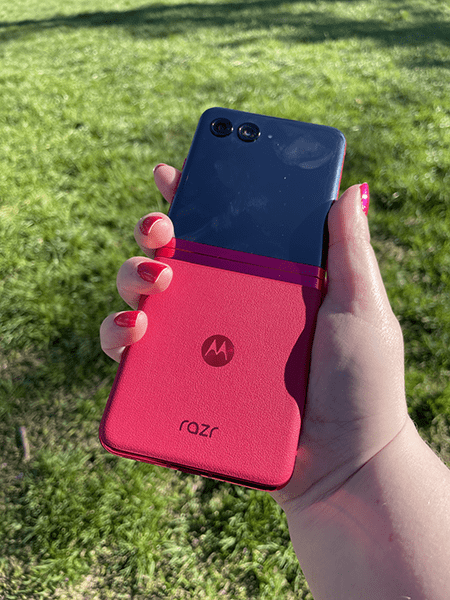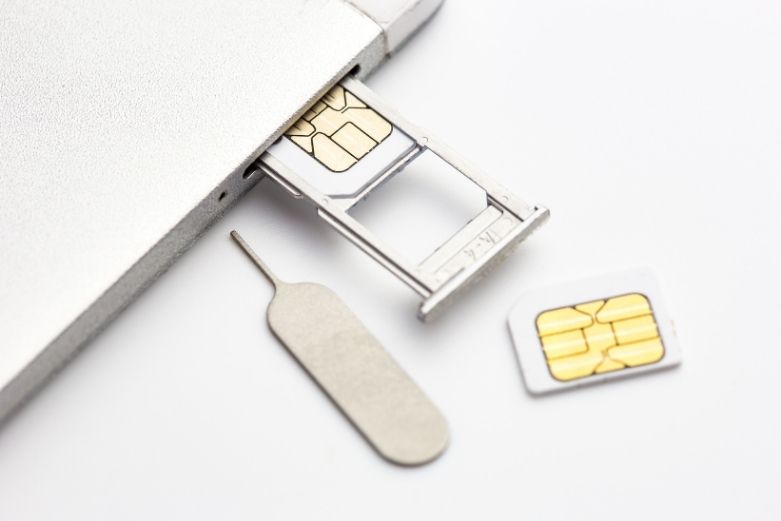Two of something is usually better than one and it’s no different with SIM cards. Dual SIM phones are the unsung heroes of the smartphone world, largely flying under the radar. In this guide, we’ll run through the benefits and perils of dual SIM smartphones, some popular models available in Australia and how you can buy one.
On this page:
Best dual SIM phones Australia
With so many dual-SIM phones on the market — whether it’s a phone with two SIM card slots or phones with physical and eSIM capabilities — it can be hard to decide which phone is the best, or indeed, which dual-SIM phone is best for you.
Best dual-SIM iPhone: iPhone 16 Pro

The iPhone 16 Pro is by far one of the best dual-SIM phones on the market. Boasting some of the best features Apple has to offer in a smartphone, excellent cameras and a performance that’s hard to fault. If you’re an iPhone user, you’ll find it hard to go past the iPhone 16 Pro.
Best dual-SIM Android phone: Samsung Galaxy S25 Ultra
While the Samsung Galaxy S25 Ultra is one of the most expensive phones on the market, it is by far one of the best dual-SIM phones you can get for your money. It boasts a range of ultra-premium features, excellent cameras and the best features Samsung has to offer in a smartphone. It offers physical dual SIM capabilities and also supports eSIM.
What other dual-SIM phones are available in Australia?
There are many smartphones in Australia with dual-SIM capability from brands like OPPO, Samsung, Apple, Motorola and Nokia. Some dual SIM devices might be available to purchase outright only, while others might be available to be bundled in with a phone plan. Make sure you check the specifications before buying and also note that if buying through a phone plan provider, you might find that the dual SIM function is disabled.
There are several smartphones available in Australia (either on a plan or to buy outright), including dual SIM capability. Here is a snapshot of some popular smartphones which use Dual SIM technology:
- iPhone 12 series and newer
- Samsung Galaxy S9, S10, S10+, S21 series and newer
- Samsung Galaxy Z Flip and Z Fold series
- Samsung Galaxy Note9 and Note10, Note10+, Note20 and Note20 Ultra series
- Samsung Galaxy A series
- Google Pixel 3a series and newer
- OPPO Find X, Find N, A and Reno series
- Motorola Edge, G, E, Razr 40 and Razr 50 series
- TCL 20, 30 and 50 series
- Nokia X, G and C series
- HMD Pulse, Pulse+, Skyline and Barbie series

If you’re still unsure about what dual SIM phone is right for you, we’ve compiled a list of some of the best dual SIM phones the Canstar Blue team has reviewed, to give you more information on which dual SIM phone might be right for you.
- iPhone 15 Plus
- iPhone 15 Pro
- Samsung Galaxy Z Flip 5
- Samsung Galaxy S23+
- Samsung Galaxy S23 Ultra
- Google Pixel 8
- OPPO Find N2 Flip
- OPPO Reno8 Lite 5G
- OPPO A78 5G
- Motorola Razr 40
- Motorola Razr 40 Ultra
- Motorola Edge 40
Postpaid offers you might like
The following table shows a selection of sponsored SIM Only plans on Canstar Blue’s database with links to referral partners.
 |
1 Month Contract (1 month min. cost $14) SIM Only Postpaid
|
30GB Data/month |
$14 Cost/month |
Go to Site |
Dual SIM phone plans
Some of the biggest phone releases of the past few years include dual SIM capabilities, however, these versions might not be available in Australia, or may only be available to purchase outright. Sometimes dual-SIM functions are also disabled or it may be unclear whether a telco is stocking a dual-SIM version of the device.
Some telcos are more upfront about this, so you’ll know whether your device is dual-SIM capable or not. Telstra, Optus and Vodafone currently carry a wide range of dual-SIM phones, offered by a variety of manufacturers such as Apple, Samsung and OPPO.
Telstra postpaid plans
The following table shows selected published Telstra postpaid plans on Canstar Blue’s database, listed in order of cost, from the lowest to highest and then by data allowance, largest to smallest. Use our comparison tool to see plans from a range of other providers. This is a selection of products with links to a referral partner.
Optus postpaid plans
The following table shows selected published postpaid Optus plans on Canstar Blue’s database, listed in order of cost, from the lowest to highest and then by data allowance, largest to smallest. Use our comparison tool to see plans from a range of other providers. This is a selection of products that may have links to a referral partner.
Vodafone postpaid plans
The following table shows selected published postpaid Vodafone plans on Canstar Blue’s database, listed in order of cost, from the lowest to highest and then by data allowance, largest to smallest. Use our comparison tool to see plans from a range of other providers. This is a selection of products that may have links to a referral partner.
How do dual SIM phones work?
Simply put, dual SIM phones can use two SIM cards at once. Some models are only ‘single configuration’ — meaning you can only use one SIM card at once — and have to switch to the other SIM in your phone’s settings. This means that if someone is trying to reach you on your other SIM card while it’s not in use, they won’t be able to — similar to having your phone switched off. This could be bad news for anyone who needs to be contactable at all hours, or if you have contacts overseas. Other models will allow you to use both SIM cards at once, which is especially useful if you want one SIM for personal use and the other for work use.
Many dual SIM smartphones have the primary SIM slot, and a hybrid slot, which can be used for a second SIM or a micro SD card, but not both. Some phones considered dual SIM may only have one physical SIM card slot, but will also support eSIM, meaning you can use a physical SIM and an eSIM simultaneously.
What is an eSIM?
Some phones (in particular, newer flagship phones made by Apple and Samsung) offer only one SIM slot and a non-physical “eSIM”, which lets you have access to two plans in the one phone, while only having one SIM. For eSIM capabilities though, your carrier will need to support the technology. Currently only some telcos offer eSIM, including Optus, Telstra, Vodafone, Everyday Mobile, Felix, More, Tangerine, Boost Mobile and Amaysim.
How do eSIM phones work?
Instead of using a physical SIM card, eSIM-capable phones carry SIM capabilities without the need for the insertable chip. eSIM’s bind to the phone, although you can unbind them to switch your plan over to another phone. This is a good solution if you want two numbers to be active at the same time, although most providers don’t have plans with eSIM functionality.

What are the benefits of dual SIM phones?
There are many benefits and potential uses for a dual SIM or eSIM smartphone, such as:
- You have a work phone and a personal phone and want to combine them, or you want a work number you are able to switch off outside of office hours.
- You want a basic ‘everyday’ plan and an extra SIM with lots of data for streaming TV shows and movies.
- You travel overseas a lot and want one slot dedicated towards your plan back home and one for your overseas SIM.
- You have one plan with better international rates and want to use that for calling family or friends overseas.
- You travel around rural Australia a lot and find one provider gets better coverage than the other.
However, dual SIM cards are not without their downsides. Very few phones, and next to none in Australia, are ‘dual active’, meaning two SIMs are able to be used at once. This means you have to manually switch between the two SIM cards in your phone’s settings. And in all likelihood, this also means you’ll be subject to paying two phone bills, unless one of these bills is paid for by your employer.
Some dual SIM smartphones only allow for the secondary SIM tray to be compatible with one mobile network, meaning you might not be able to access 4G or 5G speeds in the second tray. Dual SIM smartphones may also have to be purchased outright, as ones bundled with phone plans may have the feature disabled. There are lots of uses for a dual SIM smartphone, but keep in mind the potential downsides.
Which phone plans can you use with dual SIM phones?
As long as your smartphone is unlocked, you can use whatever SIM-only plan you wish. When you’re looking for a SIM-only plan, there are a few things to consider. Do you want prepaid or postpaid, are you happy to be on a contract or do you prefer the freedom of a month-to-month plan, plus, how much data do you need and how much are you willing to pay?
- Prepaid vs postpaid: Prepaid plans are usually with no lock-in contracts, require you to pay before you use and when you’ve used up your included value before the expiry period, you’ll generally need to recharge to continue using your plan. These plans are also available on a variety of expiry periods — from 5 or 7 days to 28, 30 or even 365 days. Postpaid is where you pay your bill at the end of the month — no recharging. The only downside is that you might have to pay for that extra use on your next bill if you go over your inclusions.
- SIM-only or phone on a plan: If you’re buying your phone outright, you’ll need to bundle with a SIM-only plan. However, some dual SIM phones may be available on a plan from one of the telcos, so if you’d prefer to split your device payments, you may want to buy your phone on a plan.
- Data: How much data you’ll need depends on how much data you will realistically use. If you only use mobile data for very occasional web browsing and emails, a plan with around 1GB of data might be enough. If you use your data regularly for social media, video and music streaming, 10GB or more might be a better option. If you’re streaming hours of videos in high definition each day, you’ll definitely need a bigger chunk of data, so maybe look at plans with data ranging from 50GB to 150GB.
- Price: How much data you need will usually determine how much you pay. The more data you want, the more you’ll pay. Plans with 1GB of data can start at under $10, while plans with over 100GB of data will generally cost somewhere around the $100 mark. There are still some cheap SIM plans that do include generous data at more reasonable prices, so its worth doing a comparison to see how much you can get for your money.
Here is a selection of postpaid plans from Canstar Blue’s database with a minimum of 10GB of data, listed in order of standard cost, lowest to highest, then by data allowance, largest to smallest. Use Canstar Blue’s phone plan comparison tool to see a wide range of plans on offer from mobile providers. This table includes products with links to referral partners.
Here is a selection of prepaid plans from Canstar Blue’s database with a minimum of 10GB of data, listed in order of standard cost, lowest to highest, then by data allowance, largest to smallest. Use our comparison tool to see a wide range of plans from other providers. This table includes products with links to referral partners.
Is a dual SIM phone worth the switch?
You may not have considered a dual SIM smartphone before, but if you have two phones – one for personal use and one for work – or you travel around a lot, it could be your new best friend. They allow great flexibility and you can also get the most out of having two phone plans, whether that’s a plan with cheap or unlimited international calls and another with lots of data. Many smartphones released in the past few years have included dual SIM by default, so it’s more likely you’ll find the next phone you buy has dual SIM anyway.
Dual SIM phones allow you to switch off your work phone after a long day and still retain the ability to text friends and family. However, these phones aren’t without their downsides, as some phones may not allow for two plans being used at once. Dual SIM capabilities are starting to become more normalised among phone manufacturers, so it’s safe to say the technology is always improving.
Dual SIM phones are a great idea, but are not without their downfalls – these may be enough to still warrant the use of two handsets instead of one. In any case, it pays to shop around by comparing phone plans and consider your own needs first.




Share this article